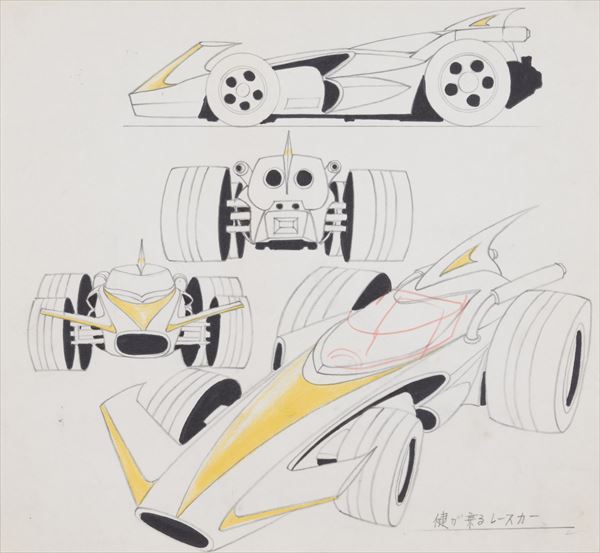“Practice Makes Perfect” How I Could be a King of this Industry Mechanical Designer, Kunio Okawara

Yatterman, Mobile Suit Gundam, Armored Trooper Votoms…
Mr. Kunio Okawara, a mechanical designer, has made kids enthusiastic about anime and involved adults which created the huge boom.
Mr. Okawara, who has been at the forefront of the anime industry for 45 years and has influenced junior designers, says he didn't choose this job happily. I interviewed him about the secret story of his huge success with a well-known anime and his working style.
(Interviewer: Minoru Sengoku certified public accountant, tax accountant /editor-Floor Corporation)
The Opportunity to Change was Marriage
Sengoku(S): I heard that you studied textile design at university and started working as a clothing designer.
Okawara(O): I wanted to use my knowledge from university, so I joined a major apparel company, Onward Kashiyama Co,Ltd. working on men's wear. However, the job was mostly laid out, so it was uninteresting for me.
Therefore I changed job to kid’s clothes brand called Otogi no Kuni, and one of the designers I met there is my wife. We thought that getting married and working in the same place could be difficult so I quit the job.
I thought, in the wedding, it would be awkward if the groom is introduced as unemployed. I looked in the jobseekers section of the newspaper and applied to Tatsunoko Production and was employed to draw the background in the art department.
S: Marriage was the reason to join Tatsunoko Production, right? So how did you go from being a background designer to a mechanical designer?
O: In the first year of joining the company, Mr Mitsuki Nakamura (who later became the art director of Gundam and Nausica of the Valley of the Wind etc…) the head of the art department, suggested I make the title logo of Science Ninja Team Gatchaman which was starting from October. I agreed and it went unexpectedly well.
After that, I was entrusted with all design jobs like enemy mech and vehicles except the main characters. I did this by following the example of other designers. Gatchaman did surprisingly well with an average audience rating of 21% for a total of 8 seasons or 105 episodes.
Next I worked on “Hurricane Polymar” “Tekkaman: The Space Knight” and when I realised, 45 years had passed.
The Inside Story of Gundam
S: You are well known as a designer of Gundam.

O: At the time I was already working freelance and established a company called “Design Office Mecaman” with Mr Nakamura who used to work for Tatsunoko Production.
It was less work though I was receiving the same amount of salary as Mr Nakamura, so I felt bad and uncomfortable. Around that time, an acquaintance who used to work for Tatsunoko Producction and changed job to Sunrise, Inc. offered me a job. After that I worked on Invincible Steel Man Daitarn 3 and then designed the mobile suit for Gundam.
S: Around that time, the occupation of mechanical designer became well known.
O: In the world of mechanical design there are those who like drawing and others who like mechanics.
Most of them like drawing but I prefer mechanics and creating things. In the 1970s the sponsor became a toy company, only I understood technical words such as “Transformation (Henkei)”and “Union (Gattai)” so I used a 3D model to demonstrate to the sponsor which received high praise.
I think using 3D models made them easy to imagine what they would look like in the showcase. Most of the time, they decided quickly.
S: At that time, Gundam became so popular. What do you think the reason was for the huge hit?
O: There were 2 products which were “Invincible Super Man Zambot 3” and “Invincible Steel Man Daitarn 3” just before Gundam and their sales were high. The sponsor was kind of relieved which is why the director was able to draw a little more realistic, mature product without telling them.
People believe the World of Gundam indicates the future of the earth. I created a proper robot anime based on an actual plan by Soviet scientists, which was “The earth is not a cradle for humans forever. Develop a rocket and transfer humans to colonies around the universe”
I believe some people really connected with the story which made them worried. For kids, it became popular because of the plastic model boom and not because of the story.
S: Can you tell me the story about the design of Gundam? At that time, Gundam had a mouth, right?
O: In the previous year, Daitarn was mainly a super robot designed as a gigantic hero. So, like Daitarn, I made a mouth for Gundam. However, I thought it strange to have a mouth even though it is an 18 meter tall mecha. It was also common to use cylinders or cuboids for arms and legs but I designed it to be more like human muscle

I was born in 1947 and the gas masks handed out in the Pacific war were under our neighbour’s veranda when I was a kid. The “Zaku” used these gas masks as a model. It was also helpful that I had drawn many jackets when working at Onward Kashiyama. And the “Zaku” has energy pipes that stick out, which is a big weak point as a weapon. I knew this but I felt having the pipes or not would project a completely different image onto people’s minds so I dared to design it this way.
Furthermore, I cared when I was designing that this should not affect children badly. In the 1970s, TV shows for kids, like anime, were on air around 6-7:30pm. This was the time for mothers to cook dinner and kids to watch TV by themselves.
Okawara Style - Method of work
S: Your designs are fantastic works which are still fresh nowadays. Did you have a hard time making them?

O: I did not wish to be a manga writer or animator when I was a child, so I was different from those people who thought like that and worked hard to get the position. In my case, I accidentally filled an empty space like a puzzle so I can’t be too arrogant (smile).
I don’t have difficulty when designing. I aim to be the perfect artisan, so when a client tells me what they want I try to design it as close as possible to their request. I try not to put myself into the work. Maybe that’s why I don’t have any difficulties.
S: So the movie “Kiminonawa” was a big topic in 2016. I feel recently there are a lot of hit anime products like Studio Ghibli work. What do you think about the current situation in the anime industry?
O: Recently people use computers to make anime with 3D and CG. It is different from the past where the animator drew each line by hand. I don’t know, though, I have an impression that’s why the lines are too complicated. I feel they have an obsession with drawing details. I think you should draw simply with less line and draw a strong character.


In old anime, we started from basic silhouettes of robots, as the story progressed we added more options and close to the end it became fully outfitted. But nowadays, from the beginning they are fully kitted out. This will make difficulty for the animator.
The animator still gets paid by one cut commission - the work environment hasn’t changed. If the design is so complicated, it takes too long to understand. If I were them I would want to make mech the animator can move as much as they want using simple formations.
S: You work in a wide field like the design of mascots for local government, next generation fire engines, micro-mini-electric-cars etc… Many customers are from the Gundam generation.
O: I can’t talk about most of my work because of privacy though over the next half year I have 3 or 4 projects. Job offers are from Hong Kong, Thailand and Singapore. The times have changed and many clients like using Skype to have meetings.
People who used to play with Gundam plastic models are around 45 years old now and they are in the position of making plans and suggestions to companies. If the generation above them retires, people who make plans will now make decisions. I’m looking forward to it.
S: What do you care about as a mechanical designer?
O: The job of a mechanical designer is to pass on the form to the animator. We used to call it “setting up (settei)” in the past.
For example, if they needed a screw in this scene, the job is to decide the form of the screw. It is not whether the design of the screw is good or not, it is to set a common understanding. So if you suggest the design which prioritises self complacency, the animator cannot understand.
Start from combining well known forms and little by little changing. So the animator will easily understand and that is a professional job. It is needed especially in commerce anime.
S: Can you send a message to people who are working hard to be like you?
O: I accidentally ended up in the anime industry. By the time 6 months had gone by a film was made which I designed and passed on to other people involved. When I watched the preview I was so impressed, I realised the attraction of the job.
I realised again that anime is team work involving a lot of people so since then I have never missed a deadline in 45 years. Because my job is quite close to the beginning, if something is wrong there, it will affect the voice actor’s job.
You should not try to put yourself into the work too much but provide what they want on time. Keep doing these things and continue.
To continue will accumulate experience and improve your skills. 45 years of continuous work is connected to today. You might say it is ordinary but “Practice Makes Perfect” is my motto and I write it down when I am asked for an autograph. “Practice Makes Perfect” it is.
 Profile
Profile
Kunio Okawara: mechanical designer
Born in 1947 in Tokyo
Graduated Tokyo Zokei Univercity
Worked at Apparel Company and then joined Tatsunoko Production in 1972
Starting from mechanical design of Science Ninja Team Gatchaman after that became expert of mechanical design
Established Design Office Mecaman
Became freelance in 1978 and joined Sunrise products
In Sunrise products, in charge of real robot anime such as Gundam, Armored Trooper Votoms to super robot anime such as Brave series. The other side, in Tatsunoko Production, he is in charge of comedy anime such as Yatterman.
He is still active as a worldwide mechanical designer










